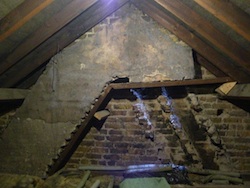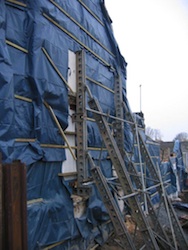 The Party Wall etc Act came into force 17 years ago but still takes people by surprise. The Act is considered to be an “enabling Act” and it can be a powerful tool to allow a Building Owner (the one wanting do the work) to carry out work on their neighbour’s property and even, in some circumstances at their neighbour’s expense.
The Party Wall etc Act came into force 17 years ago but still takes people by surprise. The Act is considered to be an “enabling Act” and it can be a powerful tool to allow a Building Owner (the one wanting do the work) to carry out work on their neighbour’s property and even, in some circumstances at their neighbour’s expense.
Sometimes the correct use of the Act can allow you to build on or across the boundary (potentially enlarging your building footprint), or to place scaffolding on the Adjoining Owner’s land, which helps maximise use of your site.
Of course, one of the main aspects of the Act is to help protect the Adjoining Owner (the one whose property may be affected) from damage by notifying them of works and allowing chance to comment.
Don’t forget to check your definitions, an Adjoining Owner may not live next door, while the actual tenant in the building may not be an Adjoining Owner. You can even have a Building Owner and an Adjoining Owner in the same building.
The Act covers work under three categories for party walls and for the “etc” part of the Act:
In general terms the Act covers:
Section 1: New walls on or astride the boundary.
Section 2: Work to a “proper” party wall (or other party structure) - altering, repairing, demolishing or rebuilding a party wall or structure; raising (or lowering) a party wall; cutting into or joining onto a party structure; cutting off overhanging parts of a party structure; exposing a party structure.
Section 6: Excavation – this could be for foundations, drainage or any other purpose - excavating to a lower level than the Adjoining Owner’s structure (within 3m); excavating to a lower level than a line 45o from the Adjoining Owner’s foundations (within 6m).
 While the garden fence probably isn’t covered by the Act, the bricks below it might well be – the definition of structure is wide and often argued over. You might have a “party wall”, which is entirely on your neighbour’s land.
While the garden fence probably isn’t covered by the Act, the bricks below it might well be – the definition of structure is wide and often argued over. You might have a “party wall”, which is entirely on your neighbour’s land.
Sometimes work can fall into more than one category, but each Section has is own requirements for notification, which must be adhered to so that the process is valid.
The maximum notice period is two months (although I have completed notification and a party wall Award in two days) but it is easy for the process to take three to four months or even longer.
An advantage of the Act, however, is that the Adjoining Owner cannot frustrate and delay permitted work beyond the fairly limited time periods set out in the Act. I am still hoping that, one day, I will be able to attend site with a Constable to break down the door of an unreasonable Adjoining Owner and allow the Building Owner’s work to proceed.
Leaving the notices too late can be expensive and, ultimately, time-consuming. The penalties for non-compliance are civil and will normally involve the Adjoining Owner taking out an expensive injunction to stop the work. I have seen informal verbal agreements be quickly forgotten, at great expense and the loss of months of work on site, when the neighbours have fallen out about another matter. The notices must be correct to allow the Act to work – if you miss something then all the time and costs that follow will be wasted.
Serving the notices correctly also gives confidence to the Adjoining Owner that their “rights” are not being ignored. Often we can then gain their agreement to the work, perhaps with the offer of a Schedule of Condition, but without the need for a Party Wall Award.
If there is a “dispute” under the Act, this is not necessarily a bad thing as it does allow the Surveyor(s) to prepare an Award, which will normally include a Schedule of Condition (which I tend to feel protects the Building Owner more than the Adjoining Owner - when the Adjoining Owner finds cracks all over their house that they have never noticed before) and sets out the rights and responsibilities of each Owner.
It is not always the case that all the costs must fall on the Building Owner. Normally this will be true assuming the Adjoining Owner is reasonable and has no need for the works to be carried out, but the Award can determine timing, method of work and cost apportionment.
An Award can also determine “any other matter arising out of or incidental to the dispute” – quite a wide ranging power.
The Building Owner is well advised not to commence work until 14 days after the Award is published as there is an appeal period for both owners in case the Award is biased or unreasonable. After that, however, the Building Owner has certainty that they can proceed in accordance with the Award.
Get your Party Wall Surveyor in early to advise on your design– this might just gain you an extra bit of space, or allow you to work with your neighbour to reduce or share costs – at worst it will just save you from getting the process wrong with the subsequent delays and costs that can involve.
Disclaimer: this article is intended to be only a general background introduction to the Party Wall etc Act and does not give legal advice, we trust you will take away an understanding of circumstances during which the Act could apply and recommend you take advice from a suitably experienced surveyor at that time.
About the author
 David Vestey is a Chartered Building Surveyor and Director of Croft Surveyors, based in the Taunton office. David has worked in private practice surveying firms since 1995 and in addition to normal design, construction monitoring and defect diagnosis has particular expertise in Party Walls, Dilapidations, Capital Allowances and Park Homes.
David Vestey is a Chartered Building Surveyor and Director of Croft Surveyors, based in the Taunton office. David has worked in private practice surveying firms since 1995 and in addition to normal design, construction monitoring and defect diagnosis has particular expertise in Party Walls, Dilapidations, Capital Allowances and Park Homes.

Have you any commercial property events you'd like to tell us about? It could be networking, exhibitions, seminars, industry lunches or sporting fixtures. We will list them for free. Just email newsdesk@propnews.co.uk with the following details: Event name, date, time, venue, cost, booking info and a brief description of the event.
To list your property job vacancies on Property News. Email: richenda@propnews.co.uk.